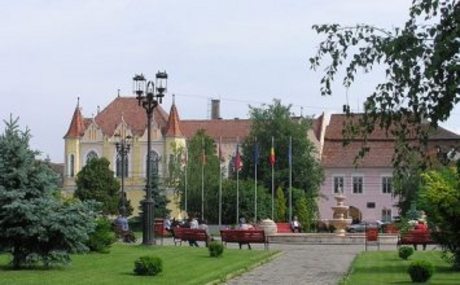Sebes
Sebes, another small Saxon town, situated on the banks of the river Sebes, is also appreciated for the remains of the citadel (14 – 15th century) burned by the Turks, just a few towers standing as an emblem of what the citadel was: Tailor’s Tower, Student’s Tower, Shoemaker’s Tower.
The first written mention of the Sebes Fortress dates back to 1387 when construction began. Damaged by invaders, it was restored in 1571. Stone-block and brick walls with eight towers were added to the original rectangular precinct. The one-mile-long walls with battlements, ramparts and openings (used to pour hot tar over assailants) have been preserved and can be seen even today. The guilds in Sebes built eight towers; only two, namely the Shoemakers’ and the Tailors’ Towers, though partially ruined, remain standing to this day. Zapolya House was built in the second half of the 15th century and served as the seat of the Transylvania Diet during the 16th and 17th centuries. Today, the building houses the local History Museum, which displays Romanian and Saxon folk art, medieval weapons, traditional pottery and icons painted on glass and wood.
Other attraction is the Evangelical Church. First built as a Roman Basilica in romanesque style, the church later took on a gothic appearance with renaissance elements. Only the nave has been preserved from of the original church built between 1240 and 1270. Throughout the centuries, gothic elements were added to the structure, such as the richly decorated choir built between 1361 and 1382. The Evangelical Church in Sebes boasts the largest altar of all churches in Transylvania. Richly decorated with paintings and carvings, the polychrome wooden altar was designed between 1518 and 1526, marking the transition from gothic to renaissance style.
The church was repainted in 1752 and again, in 1904. In the late 18th century, an organ made by Master Johannes Hahn of Sibiu was placed below the belfry. In 1893, it was replaced by a new organ made by the brothers Rieger of Jagendorf (Silesia). St Jacob’s chapel, on the north side of the church, was built in gothic style in the 14th century. Images depicting the lives of St Francis of Assisi and St Nicholas are still visible on the murals.
Originally a Dacian settlement, later incorporated into the Roman Empire, Sebes (Mühlbach in German), was settled by the Saxons in the 12th century. First documented in 1245, Sebes flourished economically and politically during the middle ages, serving as an administrative town for the region for more than five centuries between 1308 and 1876.
A renowned craft and trade center, Sebes was home to some 19 guilds – among them the armor-makers, tailors, blacksmiths, furriers, shoemakers, bakers, potters and drapers – which conducted business with the province of Walachia, as well as with central and western European cities. The downtown area of present-day Sebes, lined with colorful high-roofed 18th and 19th century Transylvanian houses, has preserved its medieval feel. The Transylvanian Diet met in Sebes in 1546, 1556, 1598 and 1600. The site of the meetings, the Zapolya House, is now a museum.
The city’s name comes from the Hungarian word sebes, meaning ‘fast’, and refers to the river that flows through the city. The German name Mühlbach stands for ‘mill river’ and refers to the hydraulic mills that were built along the river.
The city lies on the Mureș River valley and it straddles the Sebeș river. It is at the crossroads of two main highways in Romania: E68 European route - DN1 coming from Sibiu and going towards Deva and E81 European route - DN7 coming from Sibiu and going towards Alba Iulia and Cluj Napoca.
It is believed that there has been an earlier rural settlement in this area, with Romanian and Pecheneg population, situated east of today's city. But the city itself was built by German settlers - later referred as Transylvanian Saxons, but actually originating from the region of Rhine and Moselle - on the territory of the Hungarian Kingdom in the second half of the 12th century and became an important city in medieval Transylvania. Its city walls were reinforced after the Tatar (Mongol) invasions from 1241–1242, but the city was occupied in 1438 by the Ottoman Empire. Transylvania's voivode John I Zápolya died in Sebeş in 1540. The Transylvanian Diet met in Sebeș in 1546, 1556, 1598 and 1600. The location of the meetings, the Zápolya House, is now a museum.
After the union with Romania in 1918, the first mayor of the city was Lionel Blaga, the brother of the Romanian poet and philosopher Lucian Blaga, who was born in the nearby village of Lancrăm.
Sebes is not a main attraction for tourists. Beside that – don’t miss the chance to visit it. You can get there via flight to Bucharest or Cluj.




